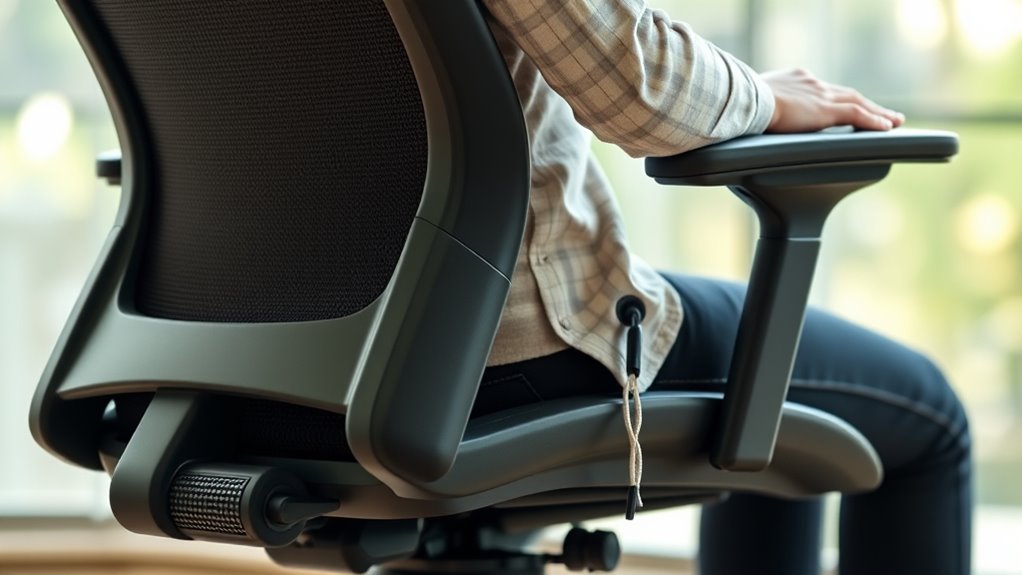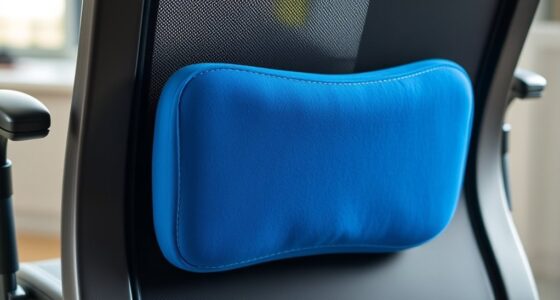To choose an ergonomic chair as a petite user, focus on adjustable features like seat height, depth, and lumbar support to guarantee a proper fit. Measure your body and workspace before selecting a chair that supports your lower back and allows your feet to rest flat. Look for compact designs with customizable armrests and stable bases for easy movement. If you keep these tips in mind, you’ll find a chair that promotes comfort and good posture—learn more to refine your choice.
Key Takeaways
- Select a chair with adjustable seat height, depth, and lumbar support to fit petite frames comfortably.
- Ensure armrests are adjustable in height, width, and angle to support relaxed shoulder and elbow positioning.
- Look for a compact chair design with a smaller seat and base for space efficiency and proper fit.
- Prioritize breathable materials and appropriate cushioning for comfort without raising sitting height excessively.
- Verify that the chair provides stable support and smooth mobility suited for petite users and your workspace.
Understanding Your Body Measurements and Needs
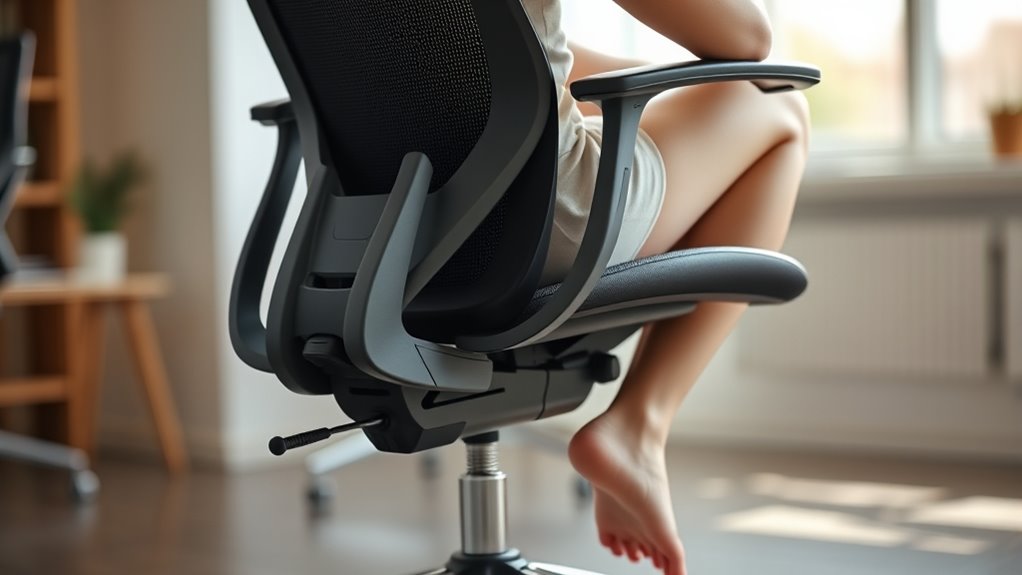
To choose the right ergonomic chair, it’s essential to understand your body measurements and needs. Knowing your height, weight, and leg length helps you find a chair that supports proper posture alignment. When your chair fits well, it encourages ergonomic benefits like reduced strain on your neck, back, and hips. For petite individuals, this means selecting a seat with appropriate depth and height to prevent slouching or overextending. Take measurements of your thighs, torso, and arms to ensure the chair provides adequate lumbar support and armrest placement. Additionally, selecting a chair with suitable dimensions tailored for petite frames can significantly improve comfort and support. By understanding these details, you can make an informed choice that promotes comfort and reduces fatigue during long hours of sitting. Ultimately, your body measurements guide you toward a chair that fits perfectly and supports your health.
Prioritizing Adjustable Seat Height and Depth
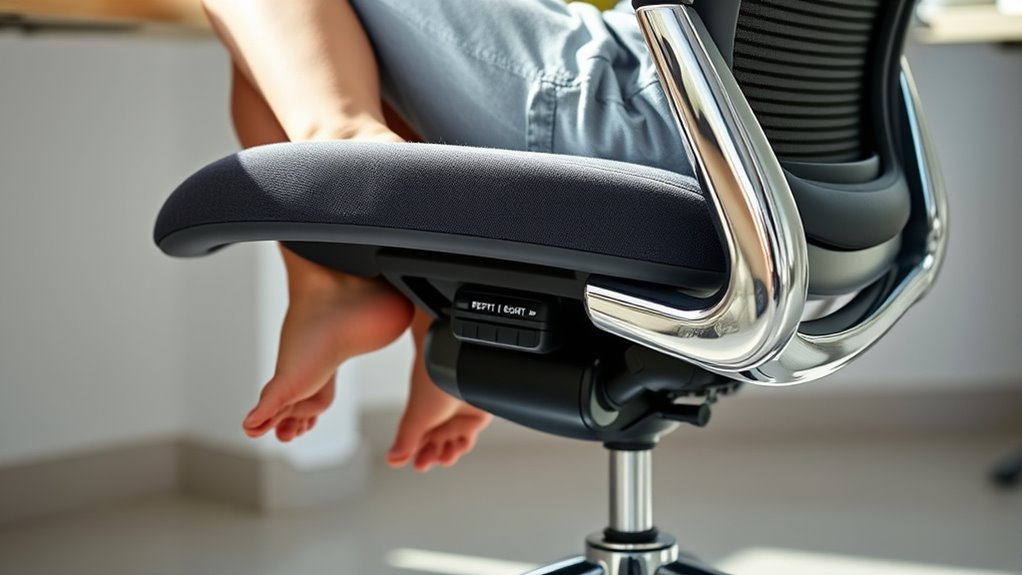
You should look for a chair with customizable seat height so your feet rest flat on the floor and your knees stay at a comfortable angle. Adjustable seat depth is also key, ensuring the back of your knees isn’t pressed against the seat. Prioritizing these features helps you find a setup that supports proper posture throughout your workday. Additionally, ergonomic furniture can significantly enhance comfort and reduce strain during long hours.
Customizable Seat Height
Have you ever struggled to find a comfortable sitting position because your chair doesn’t adjust to your body? A chair with customizable seat height allows you to maintain an ergonomic posture effortlessly. When your seat height is adjustable, your feet stay flat on the floor, reducing strain on your lower back. This feature also helps you align your hips and knees properly, providing ideal lumbar support. Proper height adjustment prevents slouching and encourages a natural spine curve. As a petite user, ensuring the seat height can be fine-tuned is essential for comfort and healthy posture. Look for chairs with easy-to-use levers or controls so you can quickly set the perfect height for your frame, promoting comfort and reducing fatigue during long hours of sitting. Additionally, calibration and adjustment features ensure the chair remains supportive and comfortable over time, especially for users with specific ergonomic needs.
Adjustable Seat Depth
An adjustable seat depth is essential for customizing your chair to fit your body perfectly. When you can modify the seat depth, it helps you maintain proper sitting ergonomics, supporting your thighs without putting pressure on your knees. This feature allows you to position your backrest at the right distance from your knees, encouraging an ergonomic posture that reduces strain. For petite users, a fixed seat depth can cause discomfort or poor alignment, so an adjustable option ensures you find the most comfortable fit. Proper seat depth promotes better blood circulation and reduces fatigue during long periods of sitting. Additionally, considering regional ergonomic trends can help you select a chair that aligns with current best practices in workplace comfort. By prioritizing adjustable seat depth, you create a more supportive, ergonomic workspace that adapts to your unique body shape and helps prevent discomfort over time.
Selecting a Chair With Proper Lumbar Support
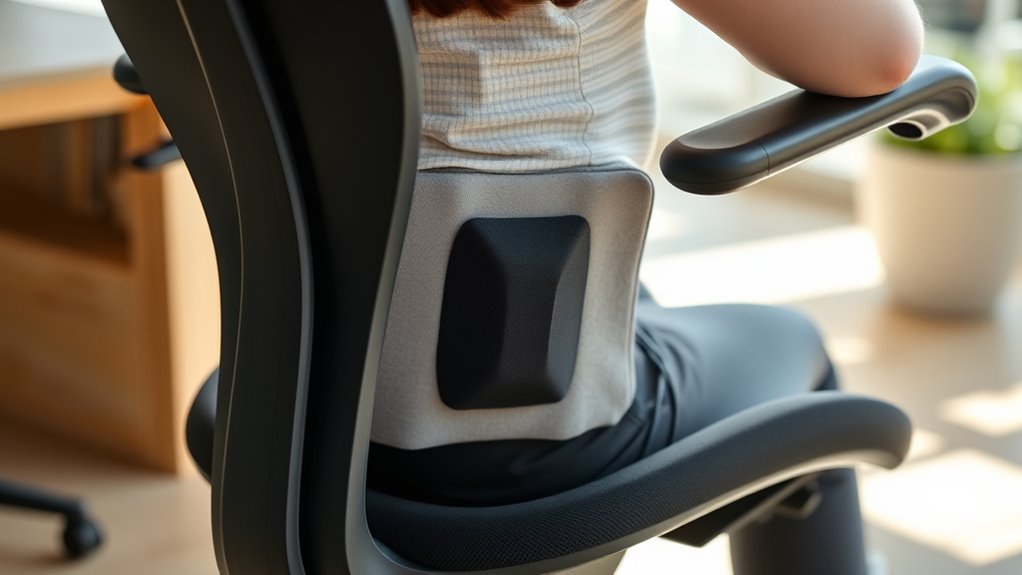
Choosing a chair with proper lumbar support is essential for maintaining good posture and preventing back pain during long periods of sitting. Good lumbar support encourages posture correction by filling the natural curve of your lower back. When selecting, imagine the support as a gentle hug that stabilizes your spine. Here’s a visual to help you picture it:
| Support Level | Comfort | Posture Correction |
|---|---|---|
| Firm | Better | Strong |
| Moderate | Good | Moderate |
| Soft | Less | Minimal |
| No support | None | None |
Look for adjustable lumbar support so you can tailor it to your petite frame, ensuring proper alignment and comfort all day long.
Ensuring the Chair Fits Your Arm Length and Desk Height
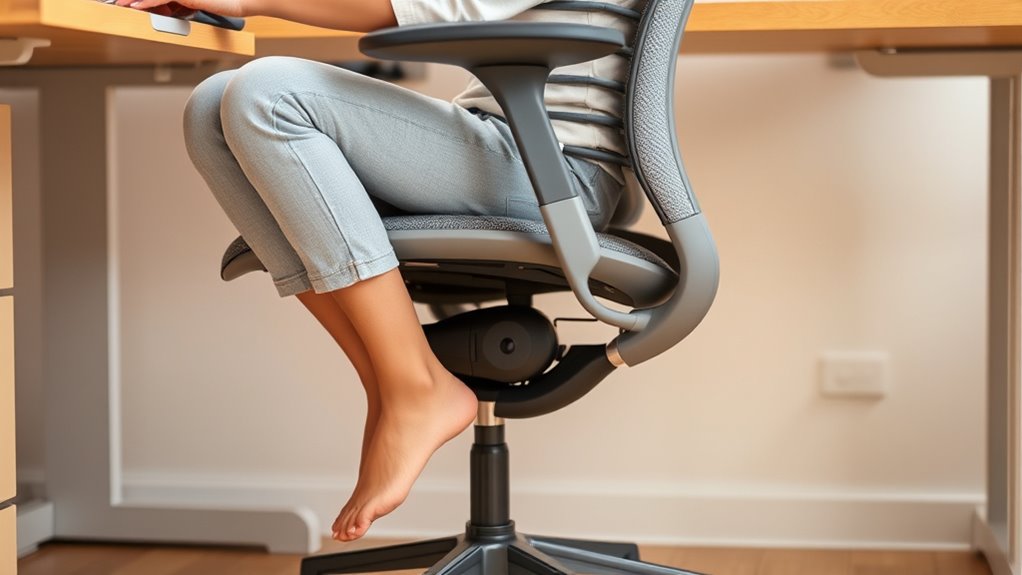
To maintain comfort and prevent strain, it’s essential to guarantee your chair’s armrests and height match your desk and body dimensions. Proper armrest height supports an ergonomic posture by keeping your shoulders relaxed and elbows close to your sides. Adjust the chair so your forearms rest comfortably on the armrests without raising or lowering your shoulders. Your desk height should allow your elbows to be at a 90-degree angle when typing or using a mouse. When selecting a chair, consider its aesthetics—look for adjustable features that blend well with your workspace. A well-fitted chair not only enhances your posture but also boosts confidence and productivity. Remember, small adjustments can make a significant difference in how comfortable and supportive your chair feels throughout the day. Incorporating ergonomic principles can further optimize your workspace for comfort and health.
Considering Seat Cushioning and Material Comfort
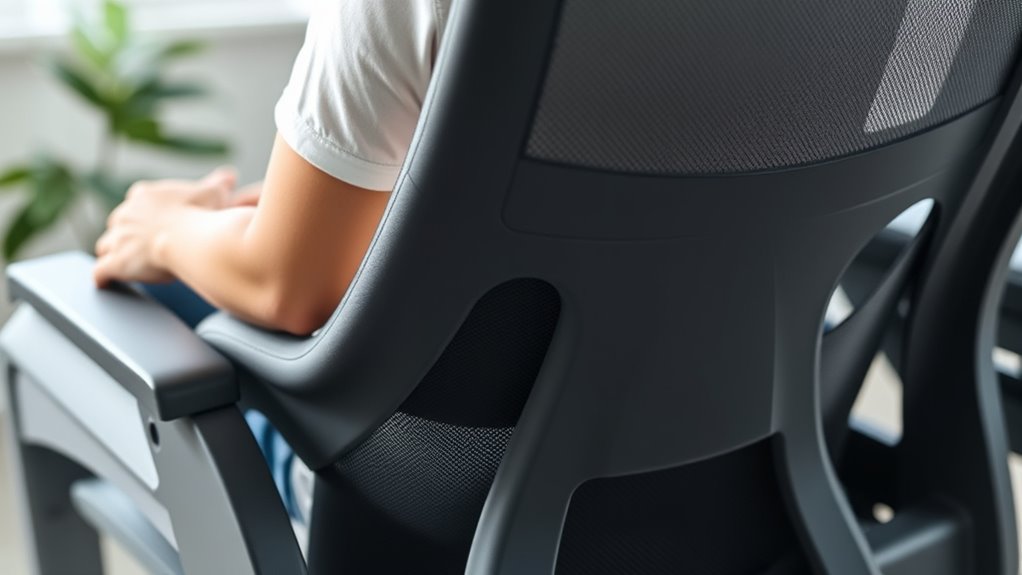
Since you’ll be spending long hours seated, selecting a chair with proper seat cushioning and comfortable materials is essential for maintaining focus and reducing discomfort. Look for a cushion with the right firmness—firm enough to support your weight without feeling hard, but soft enough to prevent pressure points. The cushion’s foam density impacts comfort, so test it if possible. Additionally, consider fabric breathability; breathable materials like mesh or ventilated fabric help keep you cool and reduce sweating. Avoid overly thick cushions that may cause you to sit too high, making it hard to reach your desk comfortably. Comfortable, well-ventilated materials prevent discomfort over time and promote good posture, ensuring you stay focused without distraction from physical discomfort. Also, choosing air-purifier-compatible fabrics can help improve indoor air quality and create a healthier workspace.
Checking for Adjustable Features to Customize Fit
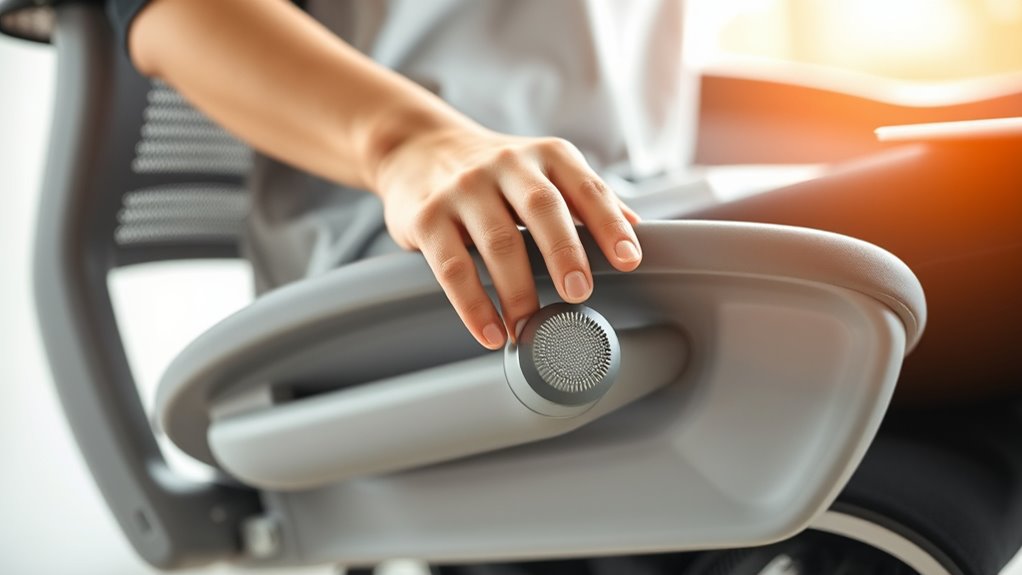
Make sure the chair offers adjustable seat height so you can sit comfortably with your feet flat on the floor. Check if the armrests are customizable to support your arms properly and reduce shoulder strain. These features help you tailor the chair to fit your body perfectly, enhancing comfort and support. Additionally, selecting a chair with ergonomic design ensures better posture and reduces the risk of discomfort during long periods of sitting.
Adjustable Seat Height
Adjustable seat height is a crucial feature to guarantee your chair fits your body comfortably. When you can easily raise or lower the seat, you promote better ergonomic posture, reducing strain on your neck and back. Proper seat height ensures your feet rest flat on the floor, with your knees at a 90-degree angle, supporting lumbar support and overall comfort. If your chair’s height isn’t adjustable, you might find yourself slouching or straining, which can lead to discomfort or injury over time. Look for a chair with a smooth, easy-to-use lever or knob to fine-tune the height. This customization allows you to create a supportive seating position that aligns with your petite frame, keeping your spine in a healthy, ergonomic posture throughout your workday. Additionally, adjustability features are often designed to accommodate different body sizes and postures, making them essential for petite users seeking comfort.
Customizable Armrests
Customizable armrests enhance your sitting experience by allowing you to tailor their position to suit your body. When choosing a chair, look for armrests that are adjustable in height, width, and angle to support your arms comfortably. Proper armrest positioning can improve ergonomic wrist support, reducing strain during long periods of typing or mouse use. Additionally, adjustable footrests complement your setup, helping you maintain proper posture and reduce pressure on your lower back. Ensure the armrests move smoothly and lock securely into place. For petite users, flexible armrests prevent reaching or overextending, promoting better alignment. By selecting chairs with customizable armrests and adjustable footrests, you create a more ergonomic workspace that adapts to your unique body shape and minimizes discomfort. Incorporating networking strategies can also connect you with ergonomic experts for personalized advice.
Evaluating the Base and Mobility Options
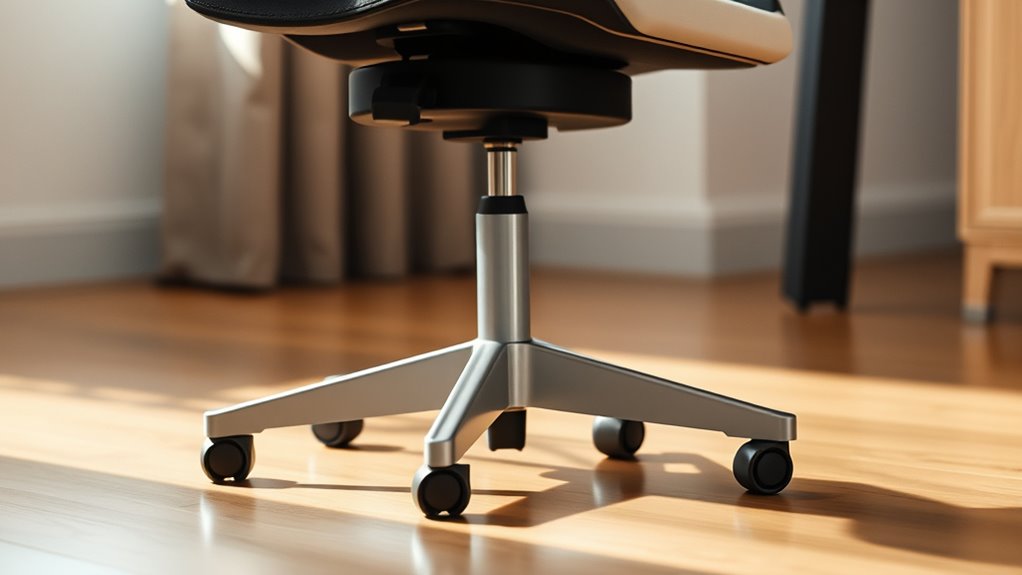
When evaluating the base and mobility options of an ergonomic chair, it’s important to contemplate how easily the chair moves and supports your workspace. Focus on the base stability to ensure it’s sturdy enough to keep you balanced, especially since petite users often need extra support. Look at the mobility mechanisms, such as casters and wheels, to make sure they roll smoothly on your flooring type. If you have hardwood or tile, consider hard-wheeled casters; for carpeted surfaces, softer wheels work better. Check that the base is low enough to support your height without tipping. A well-designed base enhances stability and mobility, allowing you to move freely without sacrificing safety or support. Additionally, understanding ergonomic design principles can help you select a chair that promotes proper posture and reduces fatigue.
Testing the Chair for Stability and Ease of Movement
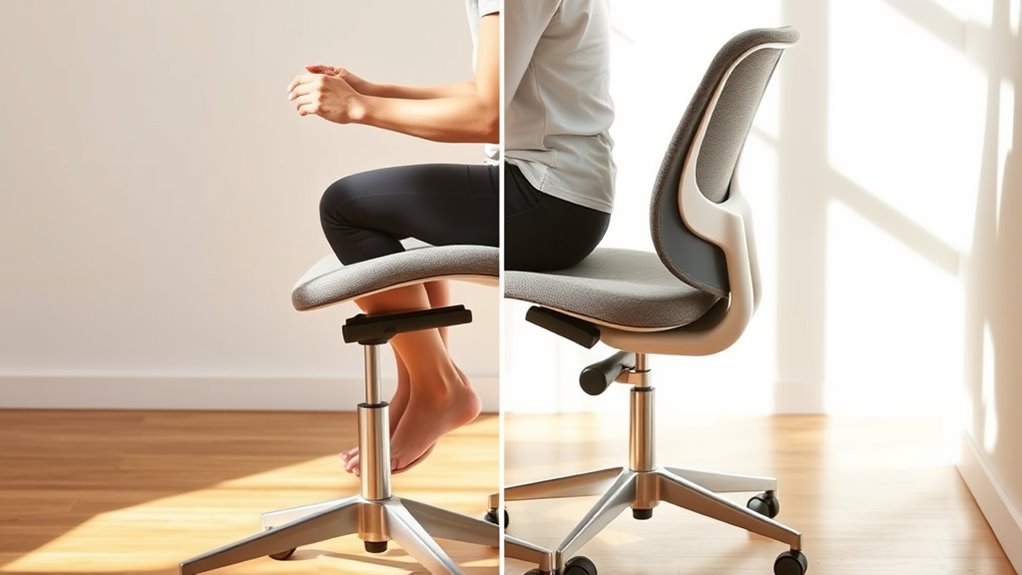
To guarantee a chair truly supports your needs, you should actively test its stability and ease of movement before making a purchase. Sit down and gently shift your weight side to side, ensuring the chair doesn’t wobble or feel unstable. Check how smoothly the rollers move when you roll around; they should glide effortlessly without sticking. Pay attention to the chair’s overall stability when leaning back or shifting positions— it shouldn’t feel shaky. While testing, consider the chair’s aesthetics and color options to match your workspace, but don’t sacrifice function for style. A stable, easily maneuverable chair enhances your comfort, especially for petite users. Remember, a good ergonomic chair combines stability, mobility, and a design that complements your space. Incorporating proper goal setting into your evaluation can help you identify what features matter most for your comfort and productivity.
Reviewing Size and Compactness for Petite Spaces
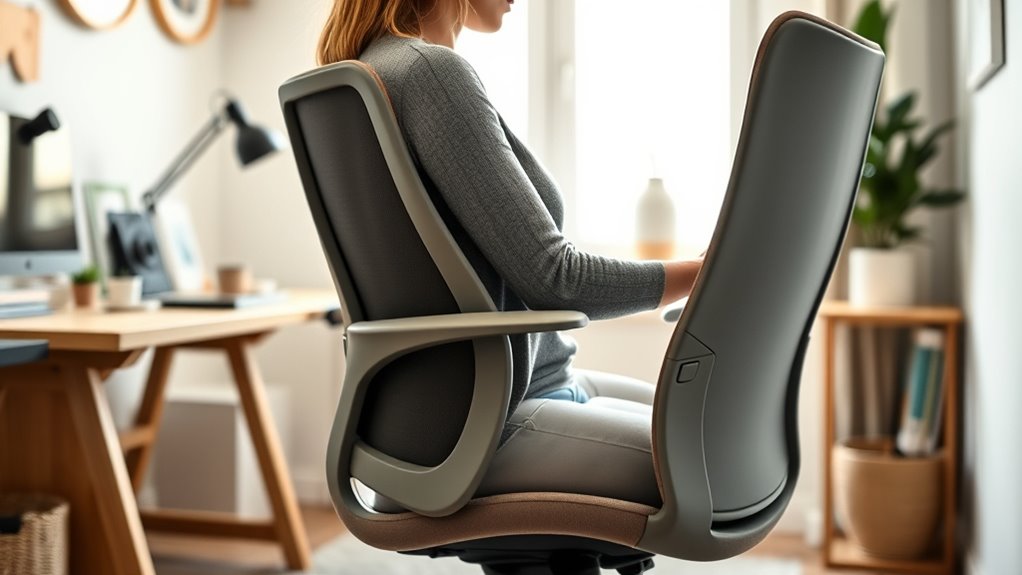
Ever considered how well a chair fits into a small or cluttered workspace? A compact design is essential if you’re working with limited space. Look for chairs with space-saving features, such as adjustable arms or a slim profile, that won’t crowd your area. Measure your available space before shopping to ensure the chair can fit comfortably without blocking pathways or other furniture. Opt for a model that offers mobility and easy maneuverability, which helps maximize your workspace. Keep in mind, smaller isn’t always better if it compromises comfort or support, so find a balance between size and ergonomic features. Choosing a chair with a thoughtful, space-efficient design ensures you stay comfortable and productive without sacrificing your small space. Additionally, selecting an ergonomic chair inspired by home decoration principles can help create a harmonious and inviting workspace that complements your petite environment.
Frequently Asked Questions
How Do I Determine the Best Chair Width for My Petite Frame?
To determine the best chair width for your petite frame, start by measuring your hips and thighs to guarantee comfort. Look for chairs with a narrower seat, typically around 16-18 inches, which better suit petite frames. You want your chair width to provide support without feeling too wide or constrictive. Test different options if possible, and choose one that allows your feet to rest flat on the floor comfortably.
What Safety Features Should I Look for in an Ergonomic Chair?
When choosing an ergonomic chair, safety features are key for comfort and support. Look for lumbar support that can be adjusted to fit your lower back, reducing strain. Adjustable armrests are also important, allowing you to customize height and width for proper arm positioning. These features help prevent discomfort and injuries, making your workspace safer and more comfortable, especially for petite users who need precise adjustments.
How Can I Assess a Chair’s Adjustability Before Buying?
Think of testing a chair’s adjustability features as tuning a musical instrument—you want everything to align perfectly. Sit in the chair and try to modify height, armrests, and lumbar support to see if they move smoothly and hold their position. Make sure you can comfortably test the ergonomic fit, especially for your petite frame. If adjustments are easy and effective, you’re more likely to find a chair that supports you well all day long.
Are There Specific Brands Known for Petite-Friendly Ergonomic Chairs?
You’ll want to look for petite ergonomic brands like HON, Humanscale, and Steelcase, known for their petite friendly designs. These brands often offer chairs with adjustable seat height, depth, and lumbar support tailored for smaller frames. When shopping, check for features like lower seat height ranges and adjustable armrests. Choosing a chair from these brands helps guarantee comfort and proper support, making your workspace more ergonomic and personalized.
How Do I Maintain Comfort During Long Hours in a Small Chair?
Did you know that poor seating can reduce productivity by up to 15%? To stay comfortable during long hours in a small chair, explore cushioning options like memory foam or gel pads for added support. Incorporate posture tips such as keeping feet flat on the floor and maintaining a neutral spine. Regular breaks and stretching also help prevent discomfort, ensuring you stay focused and comfortable throughout your workday.
Conclusion
Choosing the right ergonomic chair as a petite user isn’t just about comfort — it’s about transforming your workspace into a sanctuary of support. When you find that perfect fit, everything changes. But are you ready to make that leap? To reveal the secret to all-day comfort and prevent future aches? The right chair is waiting, just beyond your reach. Will you take the step and discover what a truly tailored fit feels like?
